Diurnal expression of functional and clock-related genes throughout the rat HPA axis: system-wide shifts in response to a restricted feeding schedule
- PMID: 19190255
- PMCID: PMC2670633
- DOI: 10.1152/ajpendo.90946.2008
Diurnal expression of functional and clock-related genes throughout the rat HPA axis: system-wide shifts in response to a restricted feeding schedule
Abstract
The diurnal rhythm of glucocorticoid secretion depends on the suprachiasmatic (SCN) and dorsomedial (putative food-entrainable oscillator; FEO) nuclei of the hypothalamus, two brain regions critical for coordination of physiological responses to photoperiod and feeding cues, respectively. In both cases, time keeping relies upon diurnal oscillations in clock gene (per1, per2, and bmal) expression. Glucocorticoids may play a key role in synchronization of the rest of the body to photoperiod and food availability. Thus glucocorticoid secretion may be both a target and an important effector of SCN and FEO output. Remarkably little, however, is known about the functional diurnal rhythms of the individual components of the hypothalamic-pituitary-adrenal (HPA) axis. We examined the 24-h pattern of hormonal secretion (ACTH and corticosterone), functional gene expression (c-fos, crh, pomc, star), and clock gene expression (per1, per2 and bmal) in each compartment of the HPA axis under a 12:12-h light-dark cycle and compared with relevant SCN gene expression. We found that each anatomic component of the HPA axis has a unique circadian signature of functional and clock gene expression. We then tested the susceptibility of these measures to nonphotic entrainment cues by restricting food availability to only a portion of the light phase of a 12:12-h light-dark cycle. Restricted feeding is a strong zeitgeber that can dramatically alter functional and clock gene expression at all levels of the HPA axis, despite ongoing photoperiod cues and only minor changes in SCN clock gene expression. Thus the HPA axis may be an important mediator of the body entrainment to the FEO.
Figures
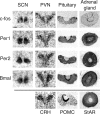

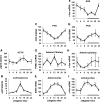
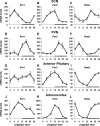
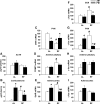
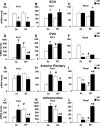
References
-
- Angeles-Castellanos M, Aguilar-Roblero R, Escobar C. c-Fos expression in hypothalamic nuclei of food-entrained rats. Am J Physiol Regul Integr Comp Physiol 286: R158–R165, 2004. - PubMed
-
- Asai M, Yoshinobu Y, Kaneko S, Mori A, Nikaido T, Moriya T, Akiyama M, Shibata S. Circadian profile of Per gene mRNA expression in the suprachiasmatic nucleus, paraventricular nucleus, and pineal body of aged rats. J Neurosci Res 66: 1133–1139, 2001. - PubMed
-
- Balsalobre A, Brown SA, Marcacci L, Tronche F, Kellendonk C, Reichardt HM, Schutz G, Schibler U. Resetting of circadian time in peripheral tissues by glucocorticoid signaling. Science 289: 2344–2347, 2000. - PubMed
Publication types
MeSH terms
Substances
Grants and funding
LinkOut - more resources
Full Text Sources
Molecular Biology Databases
Miscellaneous

